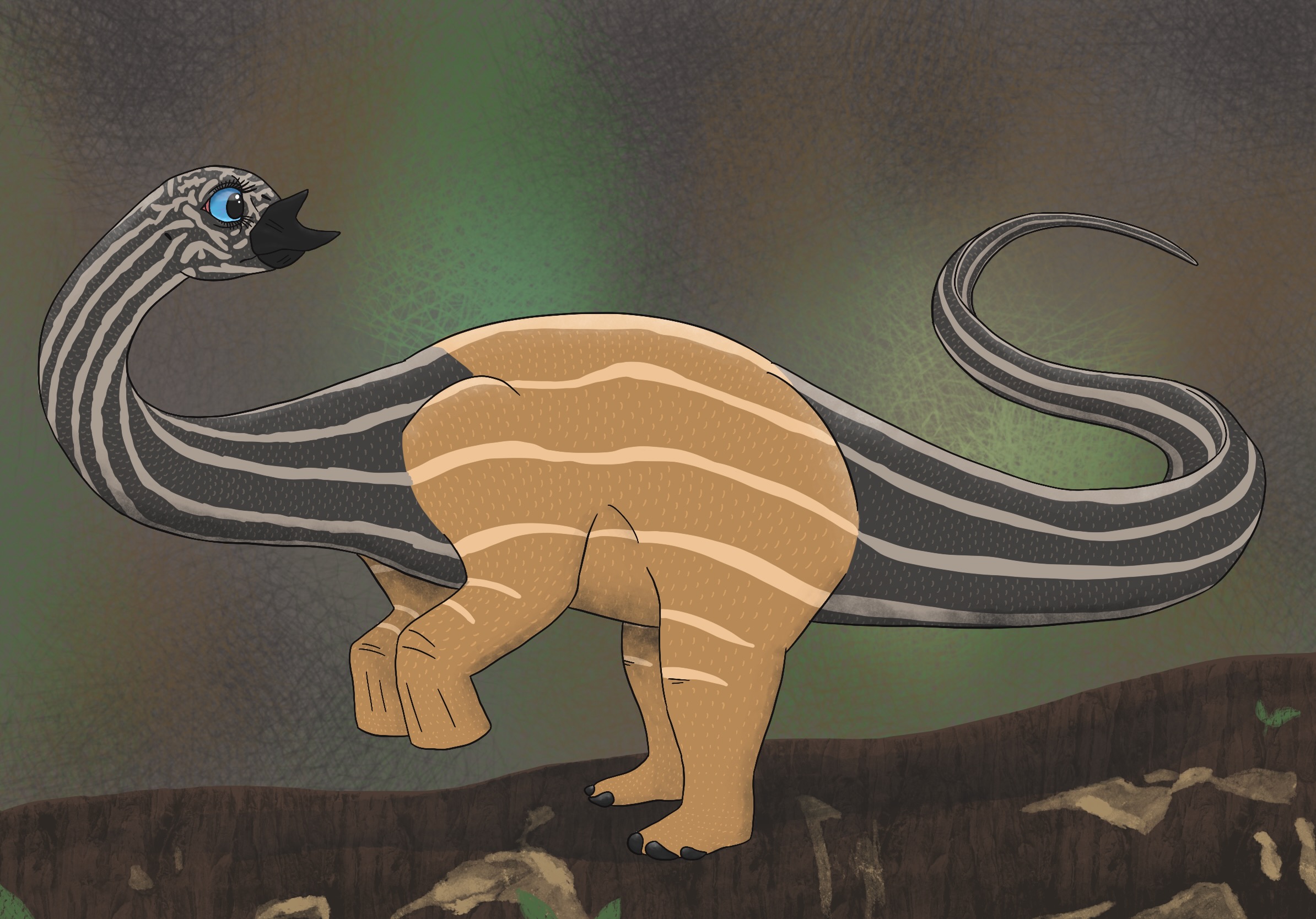“Dino Days” is a temporary exhibit of mechatronic dinosaurs in the courtyards of the Cal Academy of Sciences that I’d been putting off going to for quite awhile, even though it’s right in my backyard in SF. It’s clearly for kids, and isn’t super extensive, with just two areas with a handful of models in each place. It closes September 7, so this review isn’t all that useful I suppose, but I wonder where the statues go after they remove them. If the exhibit moves somewhere else, maybe this will still apply. Let’s jump right in!
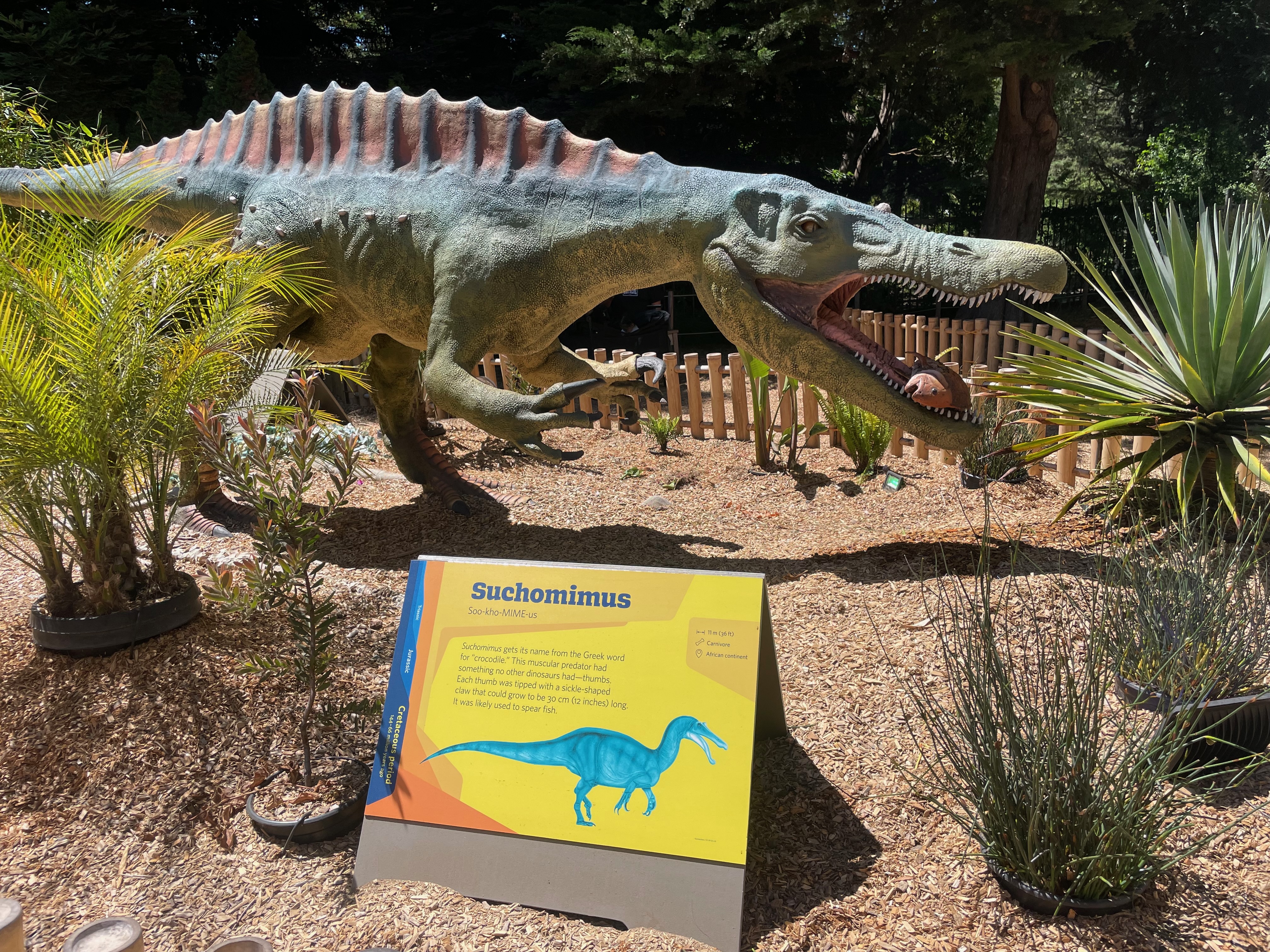
The first statue in the first courtyard is the spinosaurid Suchomimus, carrying a fish in its mouth and also…spitting…at passersby? The statue would turn its head a little, groan, and spray water out of its mouth. It seems like the artist was trying to show how this dinosaur was related to water, but instead of putting it in a watery environment just included the water in the statue itself.
All the signs in the exhibit feature paleoart by Fred Wierum, a renowned paleoartist, so kudos to them for using that. For some reason, all the art is very blue - I’m not sure if it started out that way or got really quickly sun-bleached.
While the statue gets the very basics right - horizontal posture, non-pronated hands, croc-like head, overall proportions - there are numerous issues.
- It’s way too small. The sign states correctly that Suchomimus was around 36 feet long, but the statue is only around fifteen feet.
- It’s shrink-wrapped. You can see its hipbones sticking out of its belly, as well as the outlines of the holes in its skull and its ribs.
- It shouldn’t have a sail on its back. While Suchomimus did have taller than average neural spines, they weren’t the super-elongated ones Spinosaurus had that would have been visible outside the body outline, but would have looked more like a bison-like hump.
- What’s with the comment about the thumbs? Literally all dinosaurs had thumbs. Do they mean opposable thumbs? Even if that’s the case, Suchomimus did not have opposable thumbs. I have no idea what they were trying to get across here or how they came to this conclusion.
I do like how they gave the statue slits for pupils and osteoderms, making it even more reminiscent of a crocodile. Overall, 3/10.
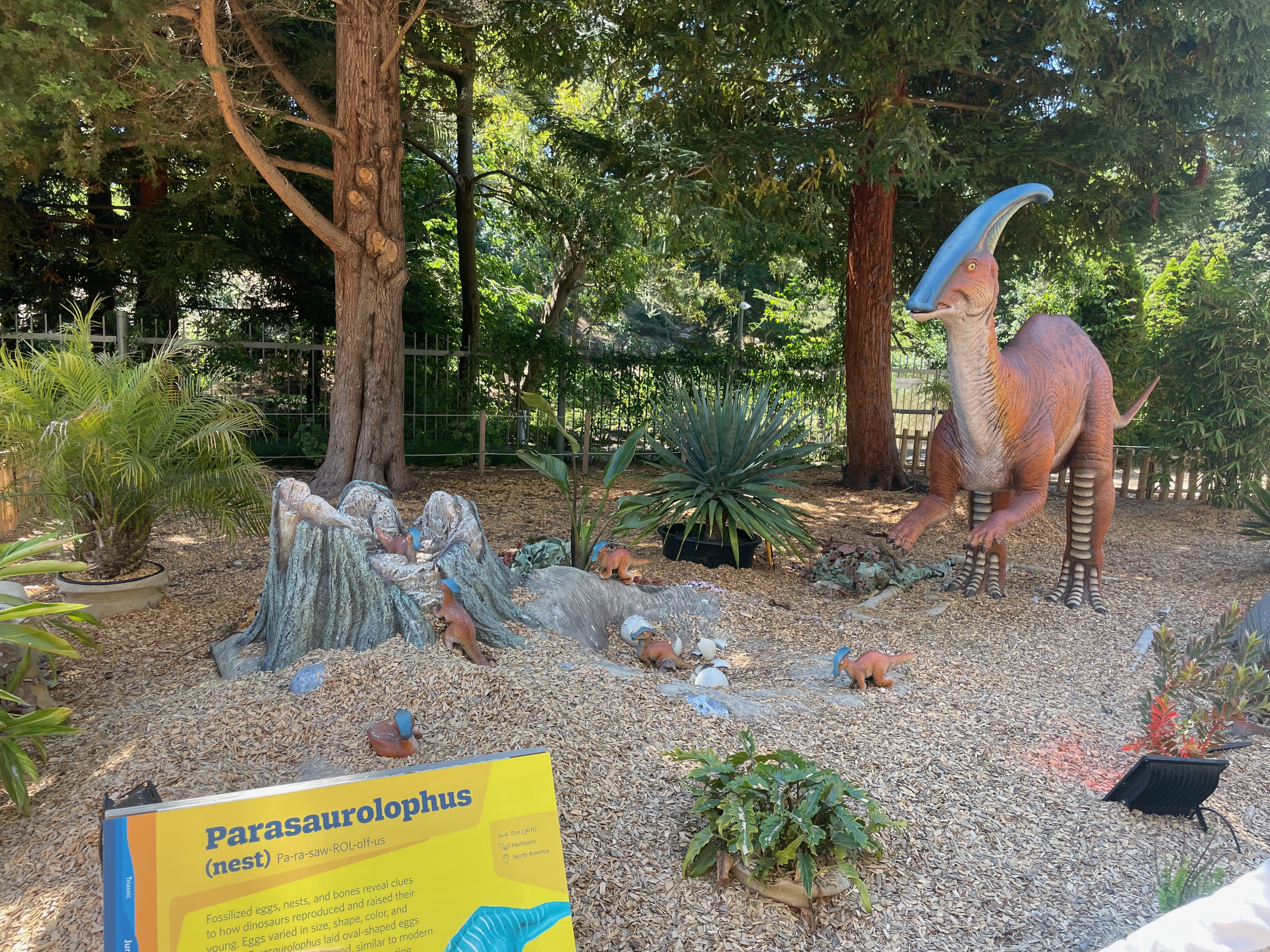
Here are a bunch of baby Parasaurolophus along with their mother. Again, the scale is way off - the sign again says 36 feet, and the statue is maybe fifteen at the most. I think it would be good to note “not to scale” somewhere. This statue moved its arms, mouth, and head, the babies moved their heads, and one of the eggs moved as if it was in the process of hatching. This one has some good aspects and some bad.
Good: Parental care was a thing in hadrosaurs, so the scene is reasonable. Also good: The hatchlings aren’t just miniaturized copies of the parent, but have shorter crests and plumper bodies. Bad: The hatchlings have crests at all, and have the same coloration as the parent. Since the crest was almost certainly a display feature, any bright colors would have developed during puberty. Good: The other sign (not pictured) mentions Parasaurolophus using its crest as a musical instrument, and that scientists were able to force air through its head pipes and get a trombone-like sound out. Bad: The sounds that the model is making are totally not that sound, they’re way higher pitched and shorter. Also bad: The adult’s legs are hyperextended and super chonky, though maybe this is just a practical consideration for the statue to be able to hold up its own weight. Overall 5/10.
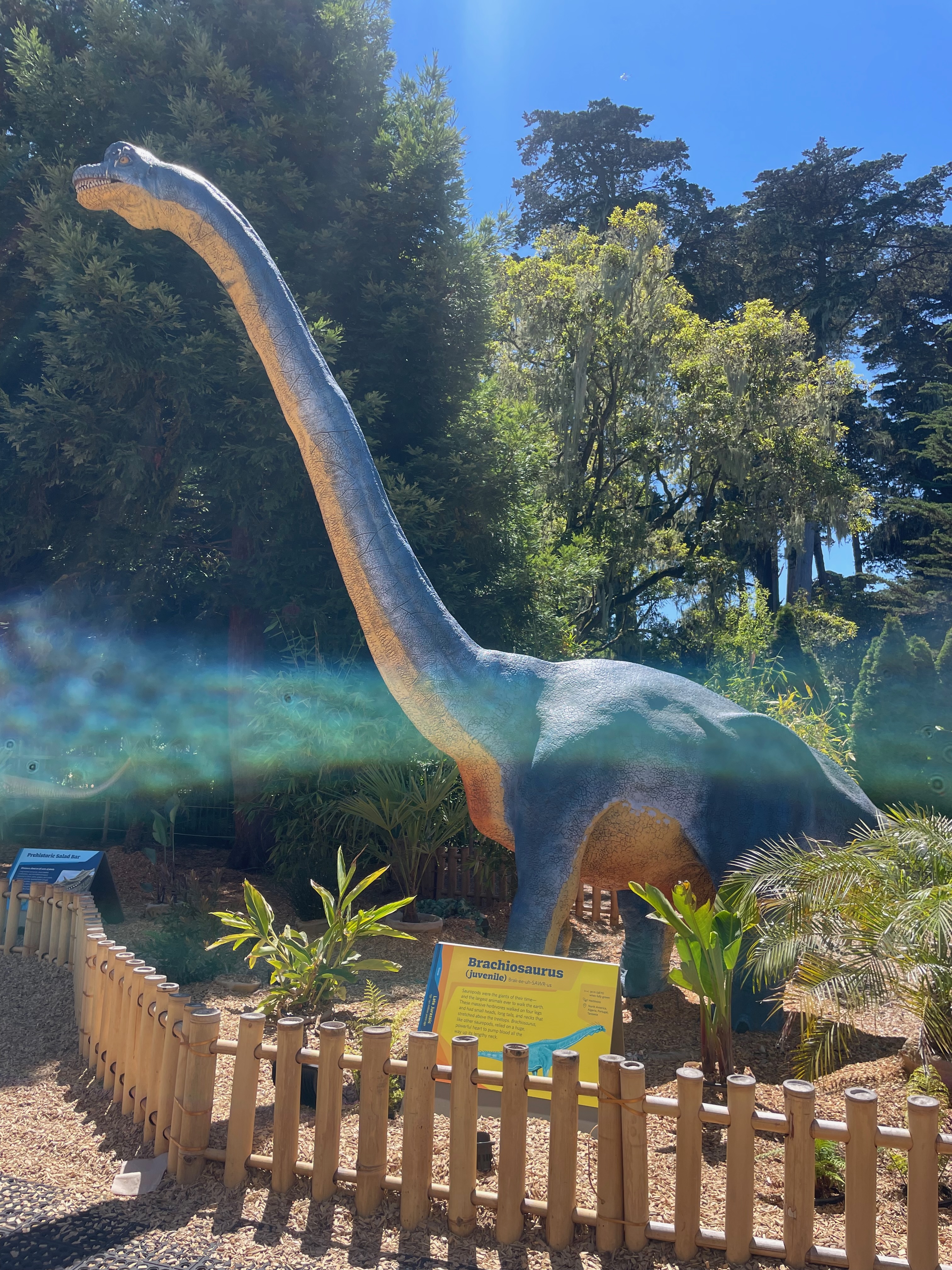
This one I actually have few complaints about. I think the sign specifies “juvenile” because this is clearly not a full-sized Brachiosaurus. It has the correct number of toes and toenails on each foot, and its body is fairly believably bulky. The only issues I could spot are that its teeth are sticking out of its mouth and that the top of its head/snout is very concave; there was likely soft tissue there in life for large, air-conditioning nasal passages. The top of the statue’s head was clearly a favorite perching spot for pigeons. Rip. 8/10.

Unfortunately, not all dinosaurs are as straightforward as sauropods. This freak of nature is supposed to be Deinonychus. Just look at the difference between the picture on the sign, which looks like a big ground-hawk, and the Halloween monster model behind it. Could the artist not tell the difference? There’s almost nothing redeeming about this statue.
- Its teeth stick out of its mouth
- It has no feathers on its face
- Its feathers look unnatural and glued-on
- It has no feathers on its hands
- It’s shrink-wrapped and its pubic bone is sticking out
- Its legs are columnar and extremely chonky
Basically, this statue follows all the tropes of “how not to draw feathered dinosaurs”. The only thing it didn’t do wrong is give it pronated hands. 1/10 for that.
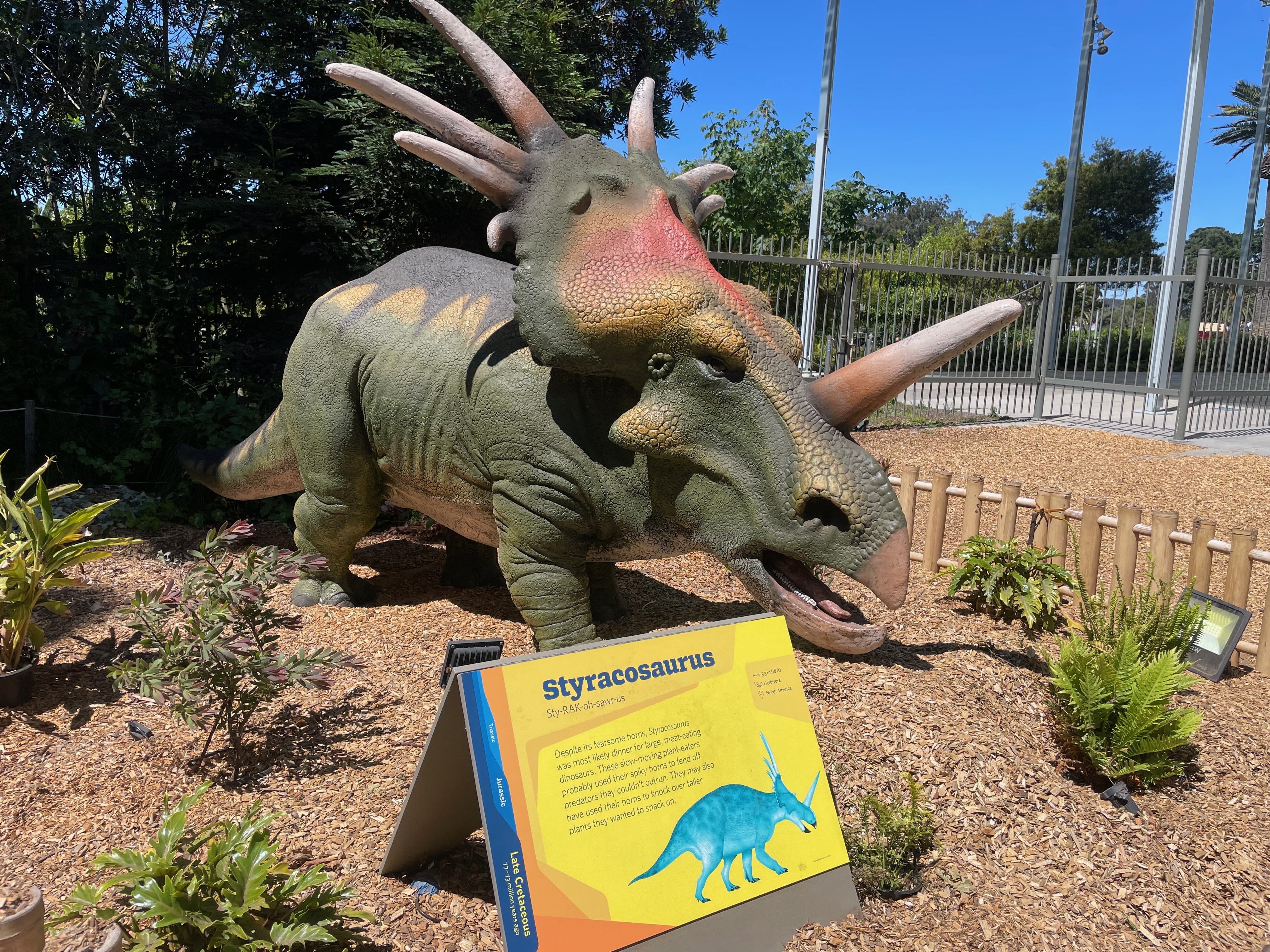
Nowhere to go from there but up. Here’s Styracosaurus. The sign isn’t wrong per se, but ceratopsians were likely quite fast, since they were built like rhinos, with thick, strong arm bones with large muscle attachment points, and their frills were pretty lightweight and would only have been used as a weapon when desperate. The statue is still a bit undersized but overall closer to accurate, but for some reason the head is enormous relative to the body. Compare the art on the sign to the statue - the proportions are totally different. Other than that, though, the depiction is fine… he just looks kind of dopey. 7/10.
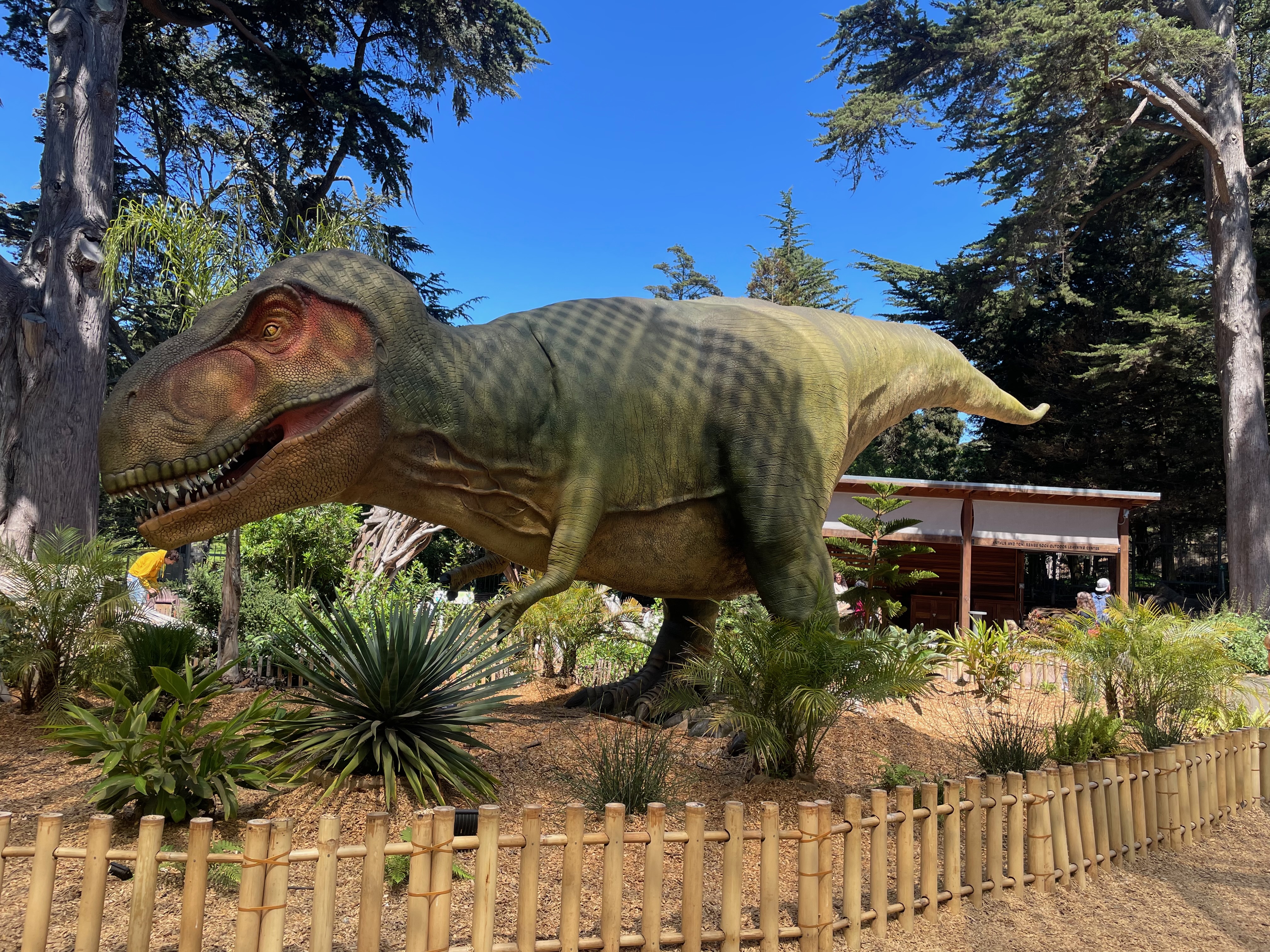
Here’s the piece de resistance - Tyrannosaurus. This is the biggest sculpture in the garden, and one of the few that seem to be actually to scale. It’s also pretty decent in gross proportions: very chunky around the middle and with powerful but not overly elephantine hind legs. The coloration is okay, though not very creative. And I wouldn’t have made the scales on the face so large, especially on the lips, but at least it has lips.
There are only a few minor issues with this one:
- The arms are much too long and skinny, detach from the body too high, and are held weirdly forward.
- You can see the skull holes through the skin of the face.
- While it does have a bit of a keratinous brow ridge, it’s missing any horn bumps on top of the snout.
Overall, though, not too bad. 8/10.
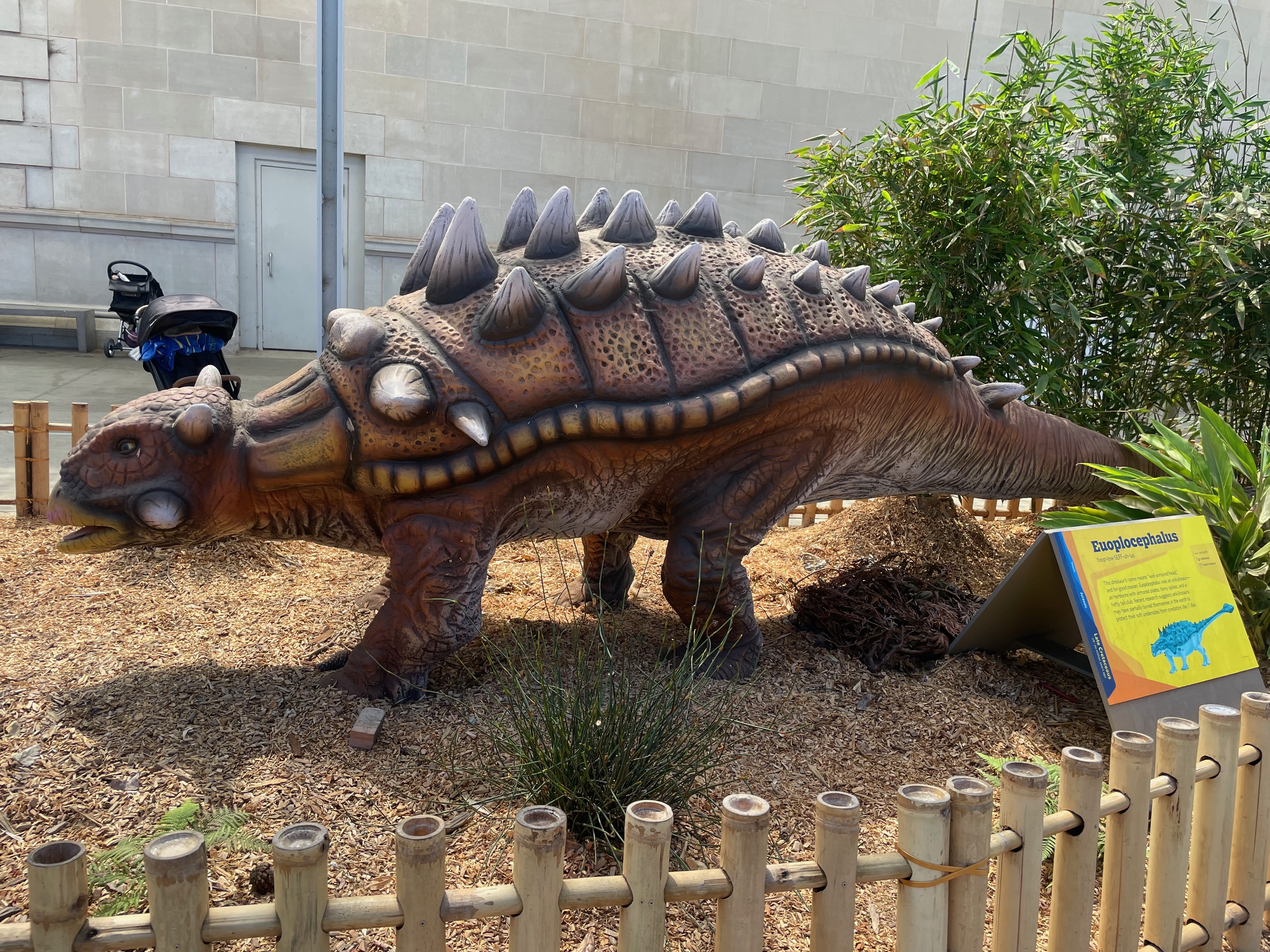
Here’s Euoplocephalus, an ankylosaur. Now this animal would likely have had to defend itself against predators rather than running away. The turtle-like carapace isn’t right. While some ankylosaurs did have large plate-like osteoderms over the hips like Polacanthus, Euoplocephalus was not one of them; its spikes would have just been buried in the skin. The shell edge that this artist has given the animal is likewise completely imaginary.
Beyond that, we have the sign, which states that recent research finds that ankylosaurs may have partially buried themselves to protect their soft undersides from predators. That’s not a hypothesis I’d heard of before, but after Googling I found this open-access paper by Phil Currie et al that does a little bit of speculation on the topic, but for some reason triggered a lot of news articles at the time (2021) reporting this specific theory. What the paper actually says is that ankylosaurs probably could dig to some extent, and that this behavior might have been useful for digging up tubers, finding water, finding minerals, or creating shallow depressions to lie in so they were less visible to predators when sleeping. The osteoderms around their edges would have helped to break up their silhouette, similar to horned lizards, which do this. However, “partially buried” to “protect their soft underbellies” is a bit of an overstatement. I’ll give them credit for trying to include a tidbit from recent research, but clearly they didn’t look beyond the headline. 4/10.
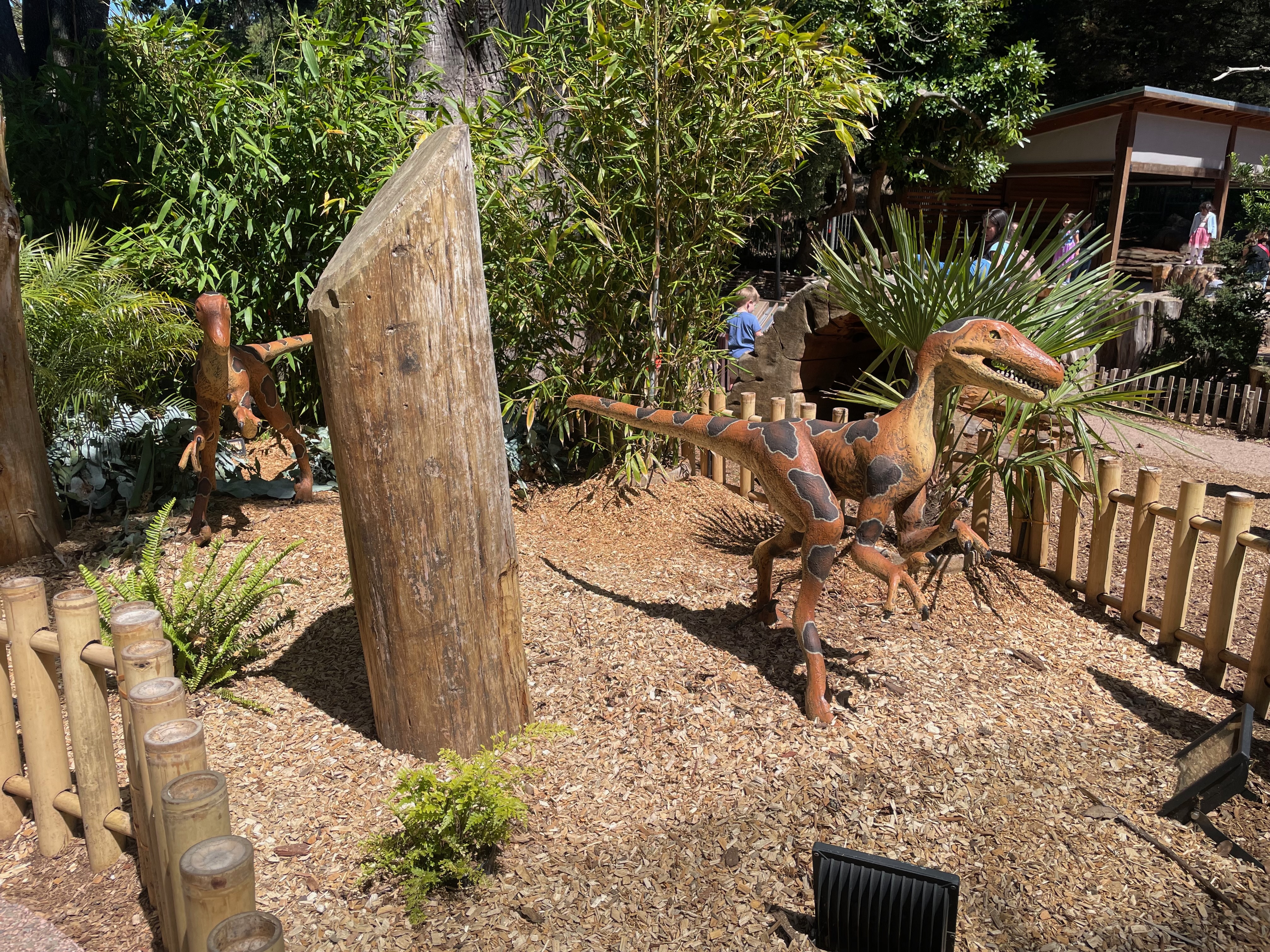
Oh god. What do we have here?
This is supposed to be Troodon, a tooth-only genus of birdlike dinosaur that’s only famous because it was discovered so long ago. Why troodontids, which are the sister group to dromaeosaurids or “raptor” dinosaurs, often don’t get the same feathering treatment as true raptors is beyond me (although we’ve seen what this artist’s feathering looks like and should maybe be grateful we were spared another Deinonychus). Both of these groups were highly birdlike, very closely related to birds and to each other, and would have probably been nearly indistinguishable from each other if you were being chased by one. Troodontids even have the sickle claw on the foot! Why does that not scream “raptor”?
Beyond just the obvious lack of feathers, these statues are so shrink-wrapped they’re basically mummified, their hands are pronated and their thumbs are weirdly sticking out, their legs are hyperextended and detach from the body waaay too far up, and their feet are… actually I’m not even sure what’s specifically wrong with the feet, they’re just weird, the toes appear fused and seem to be too short.
For context, here’s what these animals should look like, drawn by paleoartist Emily Willoughby:
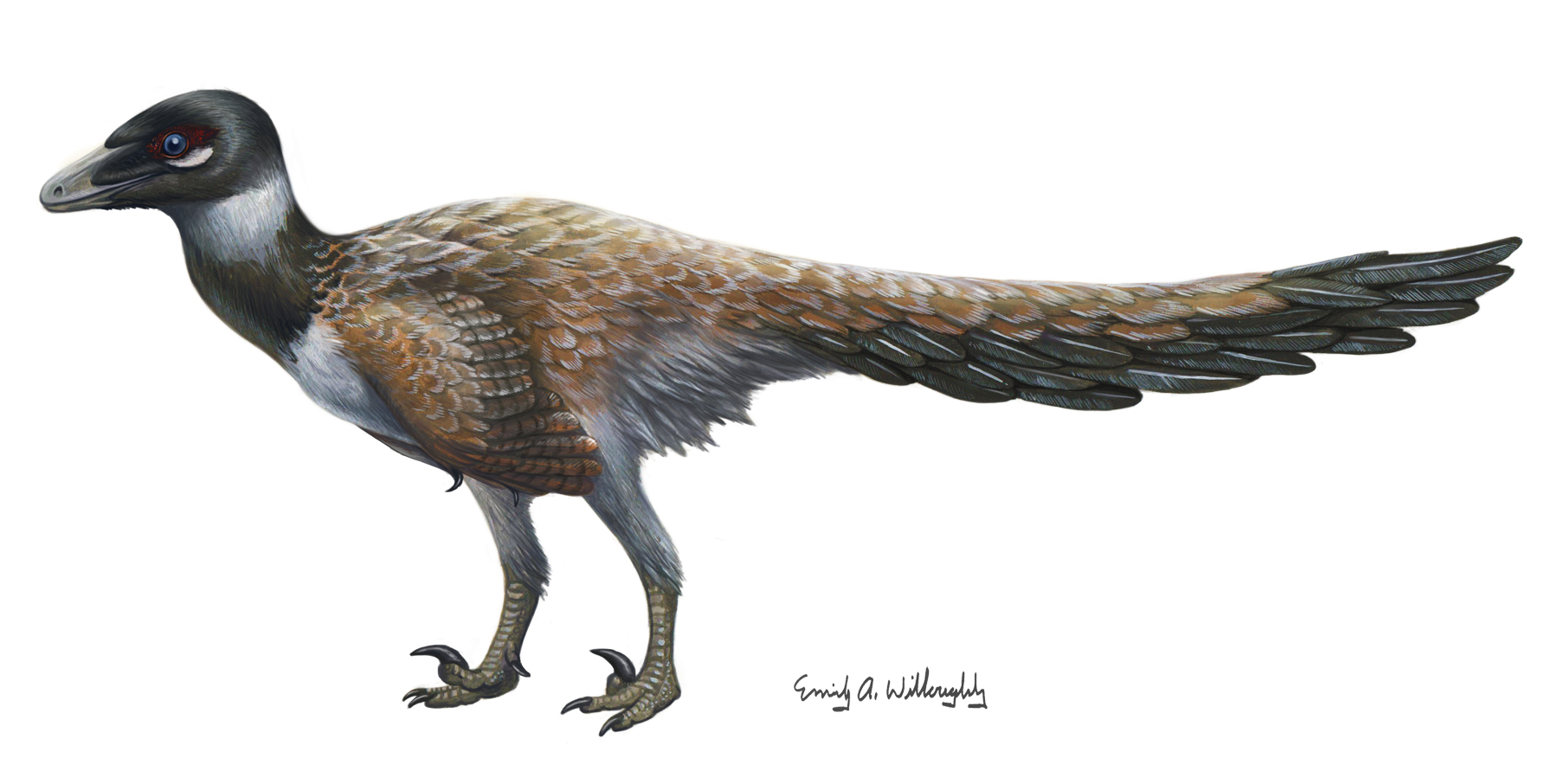
It’s night and day! 0/10.
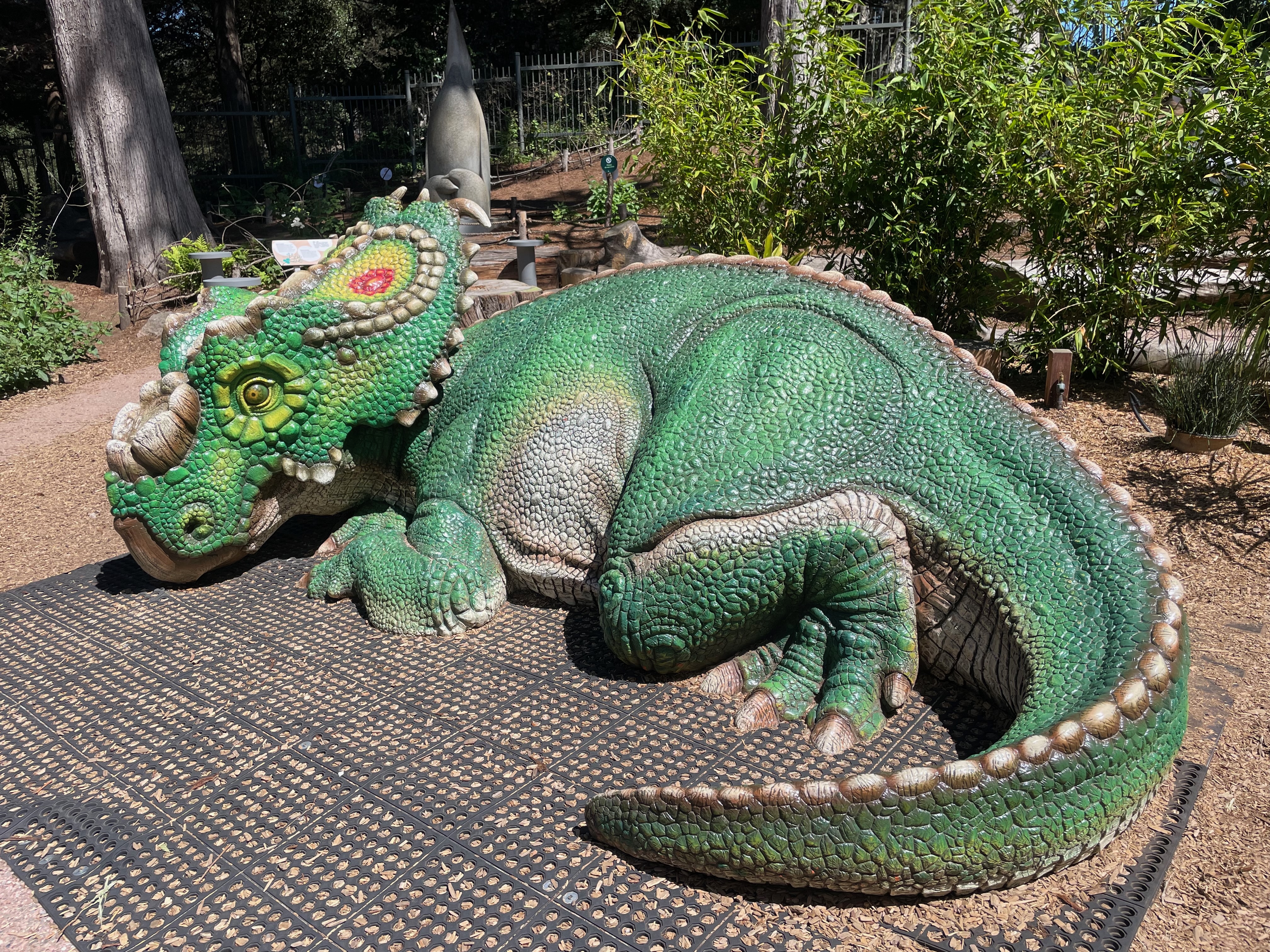
Moving on from that crime against reptilia, here’s a Pachyrhinosaurus that doesn’t move, so that you can play on/around it. That’s a fun touch! And I like the pose. He looks like a friendly dragon chameleon! The enormous scales are likely fanciful, as well as the dragon-like ridge of spines down the back, but it’s technically not ruled out. This one is also fairly close to actual size. I’ll give this one a 9/10. Mostly because it’s always fun to climb on things.

Lastly, here’s the enigmatic sail-backed sauropod Amargasaurus, the inspiration for the Pokemon Aurorus. First of all, the irony on the sign is pretty hilarious. It simultaneously claims that the sail prevented the animal from raising its neck and contains a picture of Amargasaurus with its neck erect…
Here are all the things wrong with this statue.
- Teeth sticking out of mouth (should have lips)
- Nostrils on top of head (should be on the end of the snout like, you know, all real life terrestrial animals)
- Front feet have visible nails (should only have a thumb claw)
- Baby has full sails (they would likely have developed during puberty)
- Baby has very chunky legs (would not need thick legs as a smaller animal)
- Baby is around at all (sauropods likely did not practice parental care)
- Not to scale (is less than half the appropriate size)
Overall, 3/10, mostly because Amargasaurus is a fun genus to include at all. As an aside, I Googled “did baby sauropods have proportionally short necks” (they did) and Gemini offered me this gem:

Yeeeeah. Nursing reptiles. Be careful using AI, folks…
That’s all! I hope these statues find a good home after they leave the Cal Academy. Even though they have many inaccuracies, they are certainly fun. Just an update of some of the signage and maybe giving Deinonychus a new coat would go a long way.

